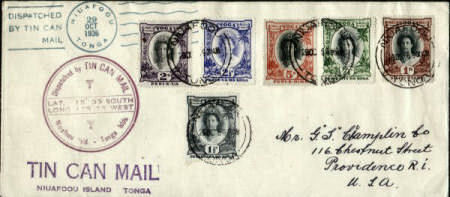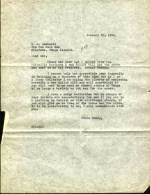![]()
Postal History Introduction
Stampless
Covers
1846
to 1900 Issues
1901-1950
Issues
1951-2003
Issues
Cancels
&
Miscellaneous
Postal
Stationery
Post
Cards
Air
Mail
First
Day &
Event Covers
Parcel Post/Special Delivery
Registered & Official Mail
Commercial & Advertising
Revenue & Postage Due
Wildlife & Game Issues
Complete List of RI Issue
Rhode
Island Around the World - International Mail
October 29, 1936 -
Tin Can Mail from
Niuafoou Island, Kingdom of Tonga
To Mr. George S. Champlin - Providence, Rhode Island
(Scroll Down for Background Information, History and Text of Letter)
|
|||
|
When I began collecting stamps back in 1958 at the age of 13, my primary interest was in world-wide issues. I bought stamps from the 5 & 10 and also approvals from several different stamp dealers. Of course my collection was limited by what a 13 year old boy with a newspaper route could afford. I had several different singles from Tonga, but of course "Tin Can Mail" was out of my reach. Over the years, my interests shifted to U.S. Airmails, Classics, First Days, and now postal history. I've always wanted to add an example of the "Tin Can Mail" to my collection, but now it also had to qualify as Rhode Island Postal History. I finally acquired an example addressed to Providence, Rhode Island and although only marginally related to RI Postal History, it does qualify. (Besides, any old excuse would have done to get one of these in my collection!) |
|||
|
George S. Champlin George had a huge world-wide stamp collection, which he donated to Brown University. Brown University receives an additional $50,000.00 a year to add new world-wide issues to the collection. Tom is one of the three trustees who maintains this collection as well as others in the John Hay Library of Brown University. The social security record for George S. Champlin indicates that he was born on February 27, 1882 and died in January of 1980. The 1930 census lists Mr. Champlin's occupation as a Jewelry Manufacturer and the name of his wife as Mabel. The Cover The reverse of the cover reads from top to bottom; E'TAIN POT CANOT COURRIER (CIDON) NIUAFOOU ISLE TONGA (French), below that is BLECHDOSEN POST (German). Both of those markings are fairly common. They are followed by a box containing the text, "Original Tin Can Mail Cover W. G. Quensell T.C.C.M. Man," which is listed as less common. The reverse is signed at the bottom, "WG Quensell," which signature type is listed as reasonably scarce. (The signature and the address on this cover were both hand-written by Walter Quensell, who was of German Nationality.) The scarcity information for the cachets was obtained from the website of Peter and Betty Billingham. Betty won a Silver medal at Johannesburg for her exhibit on Tongan Philately and Tin Can Mail. SEE: Betty's Silver Exhibit Pages for further information and detail concerning the "Tin Can Mail." Janet Klug of the American Philatelic Society and a member of the Tonga and Tin Can Mail Study Circle was responsible for gathering all of the Tin Can Cachet and Marking information together in one catalog. SEE: Tonga and Tin Can Mail Study Circle. Niuafo'ou, Kingdom of Tonga The Tongan Island Group was first settled by Polynesians around 3000 years ago and from the 10th century, it has been ruled by a line of hereditary Kings and Queens. The current ruling family began it's reign in 1845. Siaosi Taufa'ahau Tupou Maeakafawa established the line and became King of Tonga in 1845. He later adopted Christianity and in 1875 established a constitutional monarchy under the name of King George Toupu I. Queen Salote Toupu, the granddaughter of George I was the third in line of the Toupu Monarchs. She ruled Tonga from 1918 to 1965 and her son, Taufa'ahau Tupou IV is the current ruler. In 1901, in order to prevent German encroachment in the area, Great Britain established a protectorate over the Islands which lasted until 1970 when Tonga became an independent member of the British Commonwealth. The first Europeans to discover the islands were Dutch Mariners in 1616. Captain James Cook visited and charted the Islands in 1773. The islands were also the site of the "Mutiny on the Bounty." In 1789 Captain William Bligh and 18 crewmen were set adrift off the Tongan Ha'apai Group. The cover and letter above were sent in reply to a letter from a stamp collector; G. S. Champlin of Providence, Rhode Island. Mr. Champlin requested a variety of as many Tongan Stamps as possible for the two dollars he had enclosed in his letter. The letter was inserted and returned with this cover. I'm not sure if there were additional stamps included inside the envelope, however the cover is certainly franked with a very nice selection. I've also scanned the letter which is included on a separate page along with a map of the islands and a blow-up of two of the Queen Salote stamps. VIEW: Full Sized Scan of the Letter written by George Champlin |
|||
|
VIEW:
Blow-up of the
Blue 'Dispatched by Tin-Can Mail' |
|||
![]()
RI Historical
Society
The Post Offices
Home Page
RI Tercentenary Issue History
RI Philatelic Society
Recently Added Pages
Philatelic Primer
Rhode Island Around the World
Rhode Island
Town Postmarks
Other Websites of Interest
Return to 1901-1950
Stamp Issues Part 2
OR
Return to RI
International
Mail Thumbnail Page Part 3


